EARLY DOMESTICATED ANIMALS

bull painting from world's oldest village The domestication of plants and animals took place around the same time. Hunter-gatherers and village horticulturists kept pets so they knew how to take care of animals. The domestication of animals took place when animals were raised as a source of food and labor. Grains were raised with the intent of feeding people and animals.
Around the same agriculture was taking hold, people were also domesticating animals such as sheep, goats, cattle, and pigs. Some groups became herders and gatherers and thus remained nomads, while others combined herding with farming. The result of sedentary farming or it in combination with sedentary animal husbandry was permanent settlement with excess food which allowed occupational specialization and the development of cities, as well as an increase in population.. [Source: Internet Archive, from UNT]
Some animals were domesticated so long ago that they have evolved as separate species. The process, some theorize, was as much accidental as intentional. With cats, for example, the anthropologist Richard Bullet suggests, the ancestors of cats were attracted to human settlements because they kept stores of grain that attracted mice they could fed on. Humans in turn tolerated the cats because they ate mice that fed on their grain and otherwise were not threatening.
Bullet has also theorized that horses, cattle and sheep were initially not domesticated for food but were domesticated for religious sacrifices. He argues it was more easy to hunt these animals than herd them and humans would have not gone through the trouble of keeping them unless they served some other purpose. He speculated that perhaps that unruly animals were sacrificed first to avoid trouble leaving more docile animals to mate and their offspring became increasingly tame.
Good Websites Archaeology News Report archaeologynewsreport.blogspot.com ; Anthropology.net anthropology.net : archaeologica.org archaeologica.org ; Archaeology in Europe archeurope.com ; Archaeology magazine archaeology.org ; HeritageDaily heritagedaily.com; Live Science livescience.com/ ; Food Timeline, History of Food foodtimeline.org ; Food and History teacheroz.com/food
RECOMMENDED BOOKS:
“The Process of Animal Domestication” by Marcelo Sánchez-Villagra (2022) Amazon.com;
“Cows, Pigs, Wars, and Witches: The Riddles of Culture” by Marvin Harris (1989) Amazon.com;
“Domesticated: Evolution in a Man-Made World” by Richard C. Francis Amazon.com;
“Evolution of Domesticated Animals” by I. L. Mason | Jan 1, 1984 Amazon.com;
“Archaeology and Biology of the Aurochs by Gerd-C. Weniger (1999) Amazon.com;
“Aurochs and Auks: Essays on Mortality and Extinction” by John Burnside (2021) Amazon.com;
“The Cow: A Natural and Cultural History” by Professor Catrin Rutland (2021) Amazon.com;
“The Pig: A Natural History”by Richard Lutwyche (2019) Amazon.com;
“The Neolithic Revolution in the Near East: Transforming the Human Landscape”
by Alan H. Simmons and Dr. Ofer Bar-Yosef (2011) Amazon.com;
"First Farmers: The Origins of Agricultural Societies" by Peter Bellwood (2004) Amazon.com;
“Birth Gods and Origins Agriculture” by Jacques Cauvin (2008) Amazon.com;
“After the Ice: A Global Human History, 20,000–5000 BC” by Steven Mithen (2006) Amazon.com;
“The Dawn of Everything: A New History of Humanity” by David Graeber and David Wengrow (2021) Amazon.com;
“The Origins of Agriculture: An International Perspective” by C. Wesley Cowan, Paul Minnis, et al. (2006) Amazon.com;
Domestication of Different Animals
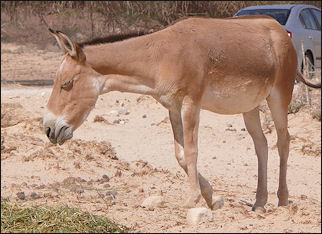
onager, precursor of donkeyAnimal, Wild Progenitor, Region of Origin, Approximate Time of Domestication
Dog, Wolf, Western Asia (Israel, Iraq), 12,000 to 14,000 years ago
Pig, Boar, Southeast Turkey, Syria, 9,000 to 10,000 years ago
Goat, Bezoar goat, Western Asia (Iran), 9,000 to 10,000 years ago
Sheep, Asiatic moufflon, Western Asia (Turkey, Syria), 9,000 years ago
Cattle, Aurochs, Western Asia (Turkey), 6,000 to 8,000 years ago
Cat, Cat, Northeast Africa, 5,000 years ago?
Chicken, Jungle Fowl, Southern Asia, 8,000 to 4,000 years ago
Reindeer, Reindeer , Northern Eurasia, Unknown
Llama, Guanaco?, South America , 7,000 years ago
Alpaca, Llama species?, South America, 7,000 years ago?
Horse, Horse, Central Asia , 6,000 years ago
Donkey, Ass , Arabia, North Africa, 6,000 years ago
Water buffalo, Water buffalo, Southern Asia, 6,000 years ago
Dromedary camel, camel , Arabia, 5,500 years ago
Bactrian camel, Camel, Central Asia, 5,500 years ago
Ducks, Ducks, Southeast Asia, 5,000 years ago
Guinea pig, Cavy, Andes in South America, 4,500 years ago
Guinea fowl, Guinea fowl, North Africa, 2,300 years ago
Mithan, Gaur, Southeast Asia, Unknown
Bali cattle, Banteng, Southeast Asia, Unknown
Rabbit, Rabbit, Iberia , Roman Era
Turkey, Turkey, North America, A.D. 100 to 500
Honeybee, Bee, Europe, A.D. 500
Goldfish, Carp, China, A.D. 960[Source: New York Times, Cambridge Encyclopedia of Human Evolution (Cambridge University Press), Dr. Michael Rosenburh/University of Delaware.
Artiodactyls (Even-Toed Ungulates)
Most domesticated animals are artiodactyls. Artiodactyls are the most diverse, large, terrestrial mammals alive today. According to Animal Diversity Web: They are the fifth largest order of mammals, consisting of 10 families, 80 genera, and approximately 210 species. As would be expected in such a diverse group, artiodactyls exhibit exceptional variation in body size and structure. Body mass ranges from 4000 kilograms in hippos to two kilograms in lesser Malay mouse deer. Height ranges from five meters in giraffes to 23 centimeters in lesser Malay mouse deer. [Source: Erika Etnyre; Jenna Lande; Alison Mckenna; John Berini, Animal Diversity Web (ADW) /=]
Artiodactyls are paraxonic, that is, the plane of symmetry of each foot passes between the third and fourth digits. In all species, the number of digits is reduced by the loss of the first digit (i.e., thumb), and many species have second and fifth digits that are reduced in size. The third and fourth digits, however, remain large and bear weight in all artiodactyls. This pattern has earned them their name, Artiodactyla, which means "even-toed". In contrast, the plane of symmetry in perissodactyls (i.e., odd-toed ungulates) runs down the third toe. The most extreme toe reduction in artiodactyls, living or extinct, can be seen in antelope and deer, which have just two functional (weight-bearing) digits on each foot. In these animals, the third and fourth metapodials fuse, partially or completely, to form a single bone called a cannon bone. In the hind limb of these species, the bones of the ankle are also reduced in number, and the astragalus becomes the main weight-bearing bone. These traits are probably adaptations for running fast and efficiently. /=\
Artiodactyls are divided into three suborders. 1) Suiformes includes the suids, tayassuids and hippos, including a number of extinct families. These animals do not ruminate (chew their cud) and their stomachs may be simple and one-chambered or have up to three chambers. Their feet are usually 4-toed (but at least slightly paraxonic). They have bunodont cheek teeth, and canines are present and tusk-like. 2) The suborder Tylopoda contains a single living family, Camelidae. Modern tylopods have a 3-chambered, ruminating stomach. Their third and fourth metapodials are fused near the body but separate distally, forming a Y-shaped cannon bone. The navicular and cuboid bones of the ankle are not fused, a primitive condition that separates tylopods from the third suborder, Ruminantia. 3) This last suborder includes the families Tragulidae, Giraffidae, Cervidae, Moschidae, Antilocapridae, and Bovidae, as well as a number of extinct groups. In addition to having fused naviculars and cuboids, this suborder is characterized by a series of traits including missing upper incisors, often (but not always) reduced or absent upper canines, selenodont cheek teeth, a three or 4-chambered stomach, and third and fourth metapodials that are often partially or completely fused. /=\
See Separate Article: ARTIODACTYLS (EVEN-TOED UNGULATES): CHARACTERISTICS, BEHAVIOR, REPRODUCTION factsanddetails.com
From Hunting to Domesticated Animals
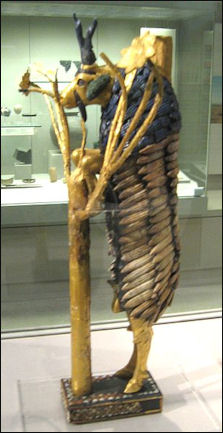
goat in Mesopotamia The progenitors of domesticated animals were hunted. With the development of agriculture early villages were built in areas where grain was eaten by people and animals was plentiful. It has been theorized that animals came to the hunters and hunters no longer to roam from place to place to find animals. Perhaps, wild animals were so plentiful that they were considered grain-eating pests instead of scarce animals that were hunted with great difficulty.
The transition from hunting big game animals to the hunting of smaller animal took place earlier in the Middle East than in Europe. As the last ice age waned hunters in what is now Turkey, Iraq, Iran, Syria, Jordan and Israel switched from hunting large animals like giant wild cattle and red deer to a diet that included sheep, goats, antelopes, fish, crabs, shellfish, birds and snails as well as acorns, pistachios and other nuts, wild legumes and wild grains.
In the early days of animal domestication, it is theorized, semi-domestic wild animals were allowed to eat the stubble left behind after the grain was harvested. Later when they were domesticated they were fed husks and stalks not consumed by humans. Later they were penned, fed stubble, milked and slaughter selectively. Selective breeding produced goats, sheep, cattle and pigs that were smaller and more docile than their wild counterparts.
The domestication of animals, led to their regulation and control, which in turn is likely to have kept them from becoming overhunted and pssobly made extinct. Draft animals were introduced in Asia about 4000 B.C.
Products and Benefits of Domesticated Animals
Animals have been exploited for thousands of years for food, labor, religious rituals and pets — and there is archaeological evidence, or at least suggestions, of many of these activities. Julie St. Jean wrote in Heritage Daily: “ The presence of different types of exploited animals may shift over time. As societies progress and incorporate new technologies, create new trade routes and extend or morph existing routes, the result is often the introduction of new species to the location. The site of Durrington Walls in Wiltshire for example, reveals evidence of a late-Neolithic shift from cattle based to pork based economy. Pigs have larger and more frequent litters which grow to maturity at a far more rapid rate than cattle and they have a propensity to be feasting animals, as they have little purpose other than for meat, and have a higher fat content deeming the animal more of a specialty product and the ability to produce an abundance of feasting animals says a lot about the economy of the society. The reasons for frequent feasting may divulge nothing more than evidence of a wealthy economy. Though, in a less wealthy society, a grand feast may represent a special occasion, wedding, holiday or ritual. More feasts bring in more guests, trade, rituals and other economy boosting features. The Durrington Walls pigs were almost entirely domestic, and as expected, were used much more for feasting than were the cattle. This is evident by the lack of butchery evidence on pig bones. Though cut and chop marks were discovered on some of the pig bones, bos bones showed the cattle to be the favoured butchered animal. The pigs appeared to be cooked often times whole; on a spit, for instance. A pig roasted whole is not likely evidence of everyday cooking but of a probable feast. [Source: Julie St. Jean, Heritage Daily, November 18, 2010 ||*||]
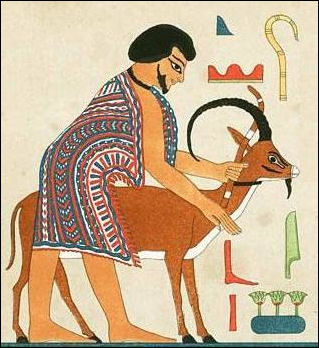
goat in ancient Egypt “The cattle population had become one of by-product production. Cattle remains found and analyzed at Durrington Walls, were those of older animals which would generally not be used for meat. These cattle were more than likely milk producing or breeding animals. Worked cattle bone evidence at the site suggests marrow extraction was taking place. This was much more relevant in cattle than in pigs perhaps as a result of the pigs being used in large-scale feasts while the cattle were the more practical, everyday animal. Another example of an animal by-product is manure. Manuring has been an essential animal by-product for many thousands of years. Animals, such as cattle, produce their fair share of waste, no matter the original use of the animal. Meat bearing males, milking females and plough pulling castrates alike are all sources of the natural and relatively inexpensive fertilizer. ||*||
“What we find archaeologically certainly is a sign of what life was like at original deposition, although, what we do not find can also tell us many things about the society as well. Crannog sites, whose contents are primarily underwater, as well as fully terrestrial sites, provide evidence of economic status displayed by butchery patterns. The Scottish crannog site of Ederline, was probably a residential site of a wealthy individual or family. There is little evidence that show animals were butchered on the site. They were likely prepared elsewhere as the heads and feet, which are usually present at a butchering site, were missing. The pre-butchered cuts of meat were most likely brought onto the crannog at the request of the owner, suggesting a wealthier occupant resided there. This sort of economic standing is often viewable archeologically. ||*||
“Another archaeologically viewable factor is the classes of people. There can be no doubt that food types and feasting methods display the status or economic standing of a person, family or society. Countless publications can attest to this notion. Serjeantson (2006) discusses which types of birds were raised and utilized by members of specific classes. Chicken and goose consumption in England began in the Roman period while the consumption of wild birds started in the early middle ages. Everyone seemed to follow suit from there. Chickens were an inexpensive, classless bird; anyone could raise and consume them along with their eggs. While rarer, more expensive birds were reserved for the higher classes. Many of these birds were also being eaten at younger ages as acquiring them was not nearly the chore it was for the lower class community. Pigs were animals often consumed by both the wealthy and the not-so; however, the manner of preparation of the meat was very different by the different classes. Fresh pork, in medieval times was a meat choice of the upper class. Albarella (2002) suggests that the meat was more readily available and accessible by the upper classes while the preserved form was the meat of necessity of the lower classed peasants. ||*||
In Dabney, Halstead and Thomas’s (2004) article regarding Mycenaean feasting, the topic of reciprocity arose with regards to the potential purpose of the feast. The bronze-age site of Tsoungiza at ancient Nemea was the focus of the paper. The use of one large cattle in the feast is suggestive of a large group of guests involved while the offering of food was more than likely presented by one person (as one person, as opposed to several, probably owned the cow). Along with zooarchaeological evidence, the archaeological remains of pottery provide evidence of ritual discarding of the kitchenware after the feast was complete. The idea of reciprocity was likely anticipated in other avenues such as political alliance or the creation of new trade partners. ||*||

“Moving to the discussion of living agricultural farm equipment, cattle, as well as other beasts of burden, have a quite obvious economic standing in agricultural societies. Animals exploited for traction have drastically changed the economy of many cultures. Large scale agriculture has become the normal food production practice in many societies across the globe. Large traction animals greatly increase the ability to grow more food products for personal consumption and for trading and selling. Economic standing of the society grows and allows for more incidents of trade and expansion of the culture. The gradual importation of new species of cattle only adds to the efficiency of the traction animals as they are bred to be stronger and more practical to the agricultural practices. ||*||
“Evidence for possible traction-induced stress on metapodials of large animals such as cattle is an excellent indicator that ploughing or heavy transport was practiced in a society. Obvious physical changes are seen in the skeletal remains of the weight bearing animals often if the loads are just too heavy, they are forced to bear weight at too early an age, and if they have grown up pulling weight. The physical changes are rather easy to see on a weight bearing animal, indicating the level of agricultural exploitation by the society.” ||*||
Early Agriculture and Domesticated Animals in Africa
The development of agriculture and livestock was different in Africa than it was elsewhere in the world. In Africa it seems that the domestication of cattle, which was first documented in Chad in 5900 B.C., preceded the development of agriculture by several thousand years and spread sporadically in fits and starts across the continent. [Source: Brenda Fowlers, New York Times, July 17 2004]
Why agriculture was so late in developing sub-Sahara Africa — the first cultivated grain, pearl millet, was first farmed around 2000 B.C. in Mauritania and Ghana — was the subject of intensive research in the early 2000s. One theory was that grain was so abundant everywhere that there was no need to settle down and farm.
Dr. Angela Close, an archaeologist at the University of Washington, told the New York Times, the first pastoralists in Africa probably captured wild animals to provide insurance as the Sahara, partly covered with grasslands in ancient times, began to dry. They then moved south and evolved into — cattle-assisted hunter gatherers — and took meat, milk and blood from their cattle for food. Pastoralism gradually spread west across the southern Sahara and reached the equator around 2000 B.C. and South Africa by the first centuries A.D. These African also developed pottery and settled communities before agriculture.
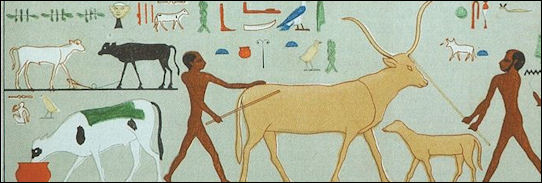
cattle in ancient Egypt
Domesticated wheat, barley, sheep and goats reached ancient Egypt by 5500 B.C. Goats and sheep were adopted by pastoralists in the southern Sahara but grains did not take hold probably because they required winter rain — in most of Africa the rains come in the summer. At ancient sites in sub-Saharan Africa cattle bones turn up with domesticated millet , suggesting pastorialists practicing agriculture. Sometimes these farmers lived in villages.
Dr. Katharina Neumann, an archeobiologist at the J.W. Goethe University in Frankfurt and author the book “Food, Fuel and Fields — Progress in African Archeobotany” (2003), said the evidence suggests that cattle in Africa were domesticated independently of the Near East about 9000 years ago and Africans found no need to develop agriculture because grasslands covered 80 of sub-Saharan Africa and many varieties of wild grasses, fruits, tubers and game could be hunted and gathered. In article in the journal African Archaeology she wrote that there has been an implicit assumption among archaeologists that “agriculture is superior to the foraging of wild plants and that with the invention of agrarian practices, economies based on wild resources are no longer competitive.”
The first domesticated plant in Africa was not a grain but rather was watermelon. Domesticated watermelon seeds dated to 4000 B.C. were found in the 1980s in southern Libya. Dorian Fuller of University College London told the New York Times, “The wild watermelon is a horrible, dry little gourd that grows in wadis of the northern savannahs but it has seeds you can roast up and eat.” The watermelon we eat was not developed until Roman times Fuller and other archaeologists hypothesize.
Domesticated Animals in Pre-Historic Meso-America

aurochs in ancient cave art In North America, animals were domesticated much later and fewer of them were domesticated than in the Old World. Only turkeys and dogs were raised for food. Eating dogs and turkeys is somewhat inefficient because dogs feed on meat, and turkeys on grain — both food favored by humans. In contrast, goats, cattle and sheep — among the first Old World animals to be domesticated — fed on foods like grass and leaves not eaten by humans.
Llamas and alpacas, the only New World animals comparable to sheep and goats, were domesticated by Andean people as a source of meat beginning around 2,500 B.C. It is believed that these animals were domesticated so late because they weren’t hunted as a semi-domesticated animals like Old World animals such as goats and cattle were.
Llamas and alpacas were useless of plowing. The mountains where there are found is not well-suited for growing many things other than potatoes anyway. In any case they were difficult to raise in captivity (vicuna, a wild relative of the llama and alpaca, doesn't mate in captivity because it can't perform its elaborate courtship ritual) and eventually took on a role like that of the camel in the Middle East.
Bison proved to be too difficult to domesticate. The Indians that lived off them seemed happy enough following their herds and hunting them anyway. Guinea pigs were domesticated the Andes about 2500 B.C.
Consequences of Agriculture and Animal Domestication
The development of agriculture, grain storage and animals domestication made it possible to for populations to expand. Women became more sedentary which made it easier to raise large numbers of children. Children were no longer a burden that had to be carried along. They could harnessed at an early age to perform agricultural chores.
The population of the Middle East jumped from 100,000 in 8,000 B.C. to 3.2 million before 4,000 B.C. (a fortyfold increase in 4,000 years).
After agriculture and herding were developed, people were from freed foraging for food and were able to develop complex technologies and social organizations that gave them an edge over the people they conquered.
Timothy Taylor, an English archaeologist, has argued that the invention of farming played a major role in the oppression of women. "The domestication of animals and the availability of animal milk in addition to breast milk meant that women could raise their children in quicker succession than before, becoming even more tied to the hearth and home in the process."
Agriculture also led to the a more hierarchal society: When irrigation was developed someone had to control the water supplies and large numbers of laborers were needed to dig the ditches. The development of irrigation about 8,200 years ago occurred at a time when the world was undergoing a mini Ice Age.
Population increases produced deforestation and soil erosion. The pressure from domesticated animals caused large areas to become transformed into scrubland. It has been theorized that as this happened meat again became scarce, nutritional standards fell, disease were transmitted among domestic animals, setting the stage for a new age in which warfare and violence would play a major part in the lives of people.
Lack of Wheel and Domesticated Animals in the Americas
.png)
auroch The Maya originated a complex system of writing and pioneered the mathematical concept of zero. Yet they never built the wheel and the only animal they domesticated for food was the turkey. In addition to not having the wheel it doesn't seem the Maya used metal either. Most of their tools were made from stone. Good goods were transported overland on the backs of human beings rather by pack animals or carts. When you consider that they built the incredible cities they did without animals and metal their achievements seem all that much more remarkable.
In New World, the wheel was invented by Indians as a children’s toy and used in pottery, but was not used more extensively arguably because of a lack of a good beasts of burden. Failure to develop the wheel left the New World technologically behind the Old World.
Anthologists believe that Old World people developed more quickly and became more technologically advanced than people in the New World because they domesticated animals earlier which in turn made it easier for them to get around easier and perform labor that required beasts of burden.
First Domesticated Goats
Goats first appeared around 5 million years ago. The lived primarily in mountainous habitats and spread out an inhabited other region. Modern goats can eat food that other animals can't partly because the originated from harsh, rocky mountain environments.
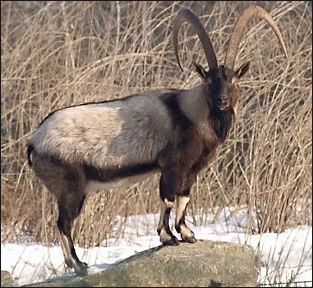
Bezoar goat Goats rank with pigs and dogs as one of the earliest domesticated animals and rank with sheep as one of the first animals to be kept for milk. Modern goats are believed to have been domesticated from Markor goats or Bezoar goats from Western Asia about 9,000 to 10,000 years ago. Wild Markor goats can still be found in the dry mountains of Afghanistan, Iran and Pakistan.
Bones from what appear to be domesticated goats have been found in Iraq and Iran dated to from 8,500 B.C. . Ganj Dareh, a 10,000-year-old site in the Fertile Crescent, yielded a number bones of many small goats. Archeologist believe that these goats were domesticated rather than wild based on the practice of hunter societies to kill the largest animals available while herders kill smaller animals and keep the large ones to breed.
People who lived in Iran 9,000 years ago kept a few males to breed and killed off the rest of the male goats at age two, about the time they reached sexual maturity, while females were allowed to grow older because they supplied milk and produced babies, a pattern that continues today.
The Mesopotamians wrote poems about goats, depicted them in golden sculptures, worshiped them as gods and made the goat-god Capricorn into a Zodiac sign. Goats were taken all over the world to trade as sources of meat, wool and milk. Goats are mentioned in the Bible as well as in Buddhist, Confucian and Zoroastrian texts. In Greek myths, the gods were nursed on goats milk.
See Separate Article GOATS: HISTORY, CHARACTERISTICS, MILK AND MEAT factsanddetails.com
First Domesticated Cattle
Modern cattle are descended from two species — wild cattle (“Bos taurus” ) of Europe and the humpbacked (zebu) cattle of Asia (“Bos Indicus” ). Most species in Europe, Oceania and the Western Hemisphere evolved from two subspecies of “Bos taurus” — the long horned aurochs (“taurus primegenius” also known as “Bos primigenius” ) and to a lesser extent from the relatively small short-horned Celtic Ox (“ taurus longifrons” ).
Cattle are believed to have been domesticated from aurochs from Western Asia between 8,000 and 10,000 years ago. Evidence of domesticated cattle has been found in archeological sites dated to 6400 B.C. Cattle appears to have been domesticated separately in Africa — with the earliest evidence of this happening occurring in northwestern Sudan about 8,000 years ago.
The bones of early domesticated cattle are thought to be from domesticated animals rather than wild ones based on the fact that the bones were mostly from males roughly the same age. If the animals were wild they would a wider range of ages and more female bones would have been present (herders often slaughter males and keep females because they produce offspring). There was also wear and tear on the vertebrae which likely indicates they had been used as beasts of burden
See Separate Article FIRST CATTLE AND COW DOMESTICATION factsanddetails.com
First Domesticated Horses

Przewalski horse
relative of first horses The Eurasia steppe is the only place that horses survived after the last Ice Age. Domestication is believed to have occurred around 3000 B.C. when horses suddenly appeared in places where they hadn't been seen before like Turkey and Switzerland. It is difficult to pin down when domestication took place partly because the bones of wild horses and domesticated horses are virtually the same. [Source: William Speed Weed, Discover magazine, March 2002]
Horses are believed to have been domesticated from wild horses from Central Asia about 6,000 years ago. Ancient men viewed horses primarily as a source of meat and hunted them like other animals. One effective method of hunting horses was driving them over cliffs.
The first domesticated horses are believed to have been horses that were herded rather than hunted. Later they were used as beast of burdens, and later still they were ridden. Horse are believed to have first been ridden to keep track of domesticated animals that ranged over large expanses on the steppe. Some people have speculated that the first horsemen drank the blood of their animals as cattle-herding tribes in East Africa do today.
The first horseback riders and domesticated horses were originally believed to have come from Sredni Stog culture, a site in the steppe areas east of the Dnieper River and north of the Black Sea in what is now the Ukraine, dated between 4200 and 3500 B.C. Russian archeologists excavated Sredny Stog in the 1960s and found scraps of bone and horn that resembled the cheek pieces of bridles plus wear and tear on the teeth of an excavated horse that resembled the wear and tear caused by wearing a bit. Archeologist David Anthony of Hartwick College in New York examined horse teeth found at Sredni Stog sites and concluded the horse teeth dated to 400 B.C., and the site not the home of 6000-year-old riders.
See Separate Articles: HORSES: CHARACTERISTICS, BEHAVIOR AND BREEDS factsanddetails.com PREHISTORIC HORSES AND HORSE EVOLUTION factsanddetails.com ; EARLY HORSE DOMESTICATION: BOTAI CULTURE, CHARIOTS, EVIDENCE AND DOUBTS factsanddetails.com
First Domesticated Pigs
Pigs are believed to have been domesticated from boars 10,000 years ago in Turkey, a Muslim country that ironically frowns upon pork eating today. At a 10,000-year-old Turkish archeological site known as Hallan Cemi, scientists looking for evidence of early agriculture stumbled across of large cache of pig bones instead. The archaeologists reasoned the bones came from domesticated pigs, not wild ones, because most of the bones belonged to males over a year old. The females, they believe, were saved so they could produce more pigs.
Pigs were originally tuber-eating forest and swamp creatures. They had difficulty living in the deserts of the Middle East because they don't sweat and therefore can't cool themselves. When pigs were first domesticated there were vast forest areas in what is now Turkey and the Middle East. There was enough water and shade to support small number of pigs, but as population in the Middle East grew, deforestation degraded the environments best suited for pigs.
See Separate Article PIGS: CHARACTERISTICS, HISTORY, PRODUCERS AND PORK-EATING CUSTOMS factsanddetails.com
First Domesticated Sheep
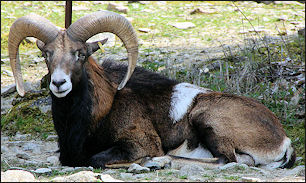
Asiatic moufflon People have worn wool for at least 12,000 years. Early wool was taken from wild sheep and goats and was likely worn with the skin attached it and as primitive felt by mashing the fibers together long before it was made into anything resembling fabric.
Sheep were first domesticated in Western Asia (Turkey, Syria and Iran) from Asiatic moufflon Ancient sheep roamed pastures and grassland with people for at least 11,000 years and are thought to have been domesticated at least 9,000 ago. Sheep bones, dated to 9000 B.C., found at a site called Zawi Chemi Shandidir in the foothills of the Zagros mountains in what is now Iran, suggests that sheep were being kept in herds at that time.
Moufflon are a kind of wild sheep still found in remote parts of Europe and Western Asia. They are small and have long legs. Both the ram and ewe have heavy ringed horns and develop a wooly undercoat in the winter and shed it in the summer. Wild moufloun still live in the mountains of Corsica and Sardinia. In the 1970s, an Asian mouflon was born to a domestic wool sheep.
See Separate Article SHEEP: THEIR HISTORY, CHARACTERISTICS AND DOLLY factsanddetails.com
Domestication of Cats
Domesticated cats (“Felis cattus”) come in three varieties: 1) house cats, 2) semi-feral types that use human as central base and come and go as they please, and 3) truly feral varieties.
Domesticated cats evolved from wild cats. Members of the domestic cat lineage include the Pallas's cat (Asia), Chinese desert cat (Asia), sand cat (Asia, Africa), Jungle cat (Asia, Africa), black-footed cat (Africa), and wild cat (Europe, Africa, Asia).
Domesticated cats first appeared around 10,000 years ago, later than dogs, sheep, and some other domesticated animals. Most likely the descendants of the African wild cats, they first appeared in the Middle East and northeast Africa when mankind switch from nomadism to a settled agricultural life in which cats were useful in exterminating rats and other grain-eating rodents. African wild cats are small pale yellow creatures with black feet.
See Separate Article DOMESTICATED CATS factsanddetails.com
Image Sources: Wikimedia Commons
Text Sources: National Geographic, New York Times, Washington Post, Los Angeles Times, Smithsonian magazine, Nature, Scientific American. Live Science, Discover magazine, Discovery News, Ancient Foods ancientfoods.wordpress.com ; Times of London, Natural History magazine, Archaeology magazine, The New Yorker, Time, Newsweek, BBC, The Guardian, Reuters, AP, AFP, Lonely Planet Guides, “World Religions” edited by Geoffrey Parrinder (Facts on File Publications, New York); “History of Warfare” by John Keegan (Vintage Books); “History of Art” by H.W. Janson (Prentice Hall, Englewood Cliffs, N.J.), Compton’s Encyclopedia and various books and other publications.
Last updated September 2024
